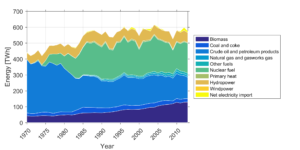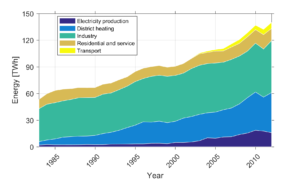Energy
Sweden’s total energy supply in 2015 was 557 GWh. The most important energy sources are nuclear fuel (33 %), crude oil and petroleum products (24%), biofuels (23%) and hydropower (12%). For the past decades, Sweden has invested heavily in alternative energy sources and is now in the front line of renewable energy use. The interaction between abundant natural resources, high oil prices, public concern for the environment, broad policy support, and strong incentives led to a transformation of Sweden’s oil-dependent energy system[1]. Despite a large per capita energy consumption, Sweden’s economy is today one of the least dependent on fossil fuels and has one of the lowest carbon emission rates. Sweden has, thus, set a model in terms of a resource-efficient and low-carbon economy that much of the world could emulate.
Figure: Total energy supply by energy commodity 1970-2013 based on data provided by Statistics Sweden.
(1) Nuclear Power
At present, Sweden has nine operating nuclear power reactors, all located in southern Sweden. These plants produce about 35-40% of the country’s electricity[2]. The first commercial nuclear reactors were built in the 1970s. Nuclear power will continue to play an important role in the Swedish energy system. Swedish law allows that new reactors may be installed on present nuclear power plant locations, but the total number of reactors may not exceed ten.
(2) Crude oil and petroleum products
Sweden relies on crude oil imports (mainly from the North Sea and Russia), which are mainly used for vehicle fuel[2]. Consequently, Sweden depends on a functioning international trade in oil to maintain the transport sectors. Since the early 1970s, crude oil usage has been reduced by 60% from 336 GWh to 134 GWh, mainly due to a decreasing use of fuel oils in the house market[2].
(3) Biofuels
Biofuels play a major role in industry, district heating, and to an increasing degree also in electricity production and transport. Biofuel is a collective term for several different types of fuels, including densified and undensified wood fuels, black liquor, biofuels from agriculture, combustible waster, bioethanol, biodiesel and biogas. The biofuel market in Sweden is presently growing at a rate of 3 TWh per year, which equals 1.5×106 m3 of wood[3]. At present, the two leading biofuel sources are undensified wood (41%) and black liquor (33%), followed by densified wood (8%) and municipal waste-bio (7%). The increasing use of biofuels for electricity and heat production has caused a rising demand for wood fuels[2], which has been satisfied through increased extraction of forest biofuels[3]. The market is expected to grow further in the near future[4] and the supply of forest biomass for energy could potentially increase by 70%[1].
Figure: Use of biofuels, waste and peat by sector 1983–2012
As the market further grows, the question arises as to whether the supply of forest biomass for energy can further be increased. The competition between forest land, water and energy resources is further intensified by changing climate conditions. Knowledge gaps and considerable uncertainties on how environmental systems will change and their impacts are major challenges.
(4) Hydropower
Sweden is the largest hydropower producer in the EU and the tenth biggest in the world, generating on average 67 TWh of electricity per year. Most hydropower is produced in northern Sweden. The annual hydropower output varies depending on seasonal precipitation: during the past 15 years, hydroelectric output varied from 53 TWh in 2003 (European summer drought) to 79 TWh in 2000 (particularly wet year). Swedish hydropower provides a valuable source of renewable energy and is able to balance the national electricity grid[5]. However, about three quarters of the largest river systems are affected by fragmentation from water regulation[5], causing negative ecological consequences. Swedish law prohibits hydropower constructions in four of the biggest streams and a number of smaller rivers, and, thus, limits further expansion of hydropower. Large uncertainties remain in terms of the effect of future seasonal shifts in water availability (e.g., more streamflow during winter, but expected longer drought period during summer) on hydropower, which highlights the need for further research.
References:
[1] Andersson, K. (2012), Bioenergy, the Swedish experience: how bioenergy became the largest energy source in Sweden.
[2] Energimyndigheten (2016), Energy in Sweden 2015, Swedish Energy Agency, Eskilstuna, Sweden.
[3]de Jong, J., C. Akselsson, H. Berglund, G. Egnell, K. Gerhardt, L. L̦nnberg, B. Olsson, and H. Stedingk (2014), Consequences of an increased extraction of forest biofuel in Sweden Рa synthesis from the biofuel research programme 2007-2011: Summary of the Swedish Energy Agency report no. ER2012:08 (in Swedish), IEA Bioenergy Task 43: Biomass Feedstocks for Energy Markets, IEA Bioenergy.
[4] Energimyndigheten (2013), Comprehensive assessment of the potential for exploiting high-efficiency cogeneration, district heating and district cooling, Swedish Energy Agency, Eskilstuna, Sweden.
[5] Rudberg, P. M. (2013), Sweden’s evolving hydropower sector: renovation, restoration and concession change, Stockholm Environment Institute, Stockholm, Sweden.

